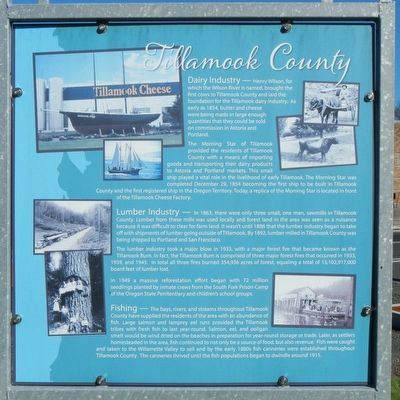Tillamook in Tillamook County, Oregon — The American West (Northwest)
Tillamook County
The Morning Star of Tillamook provided the residents of Tillamook County with the means of importing goods and transporting their hairy products to Astoria and Portland markets. This small ship played a vital role in the livelihood of early Tillamook. The Morning Star was completed December 29, 1854 becoming the first ship to be built in Tillamook County and the first registered ship in the Oregon Territory. today, a replica of the Morning Star is located in front of the Tillamook Cheese Factory.
Lumber Industry -- In 1863, there were only three small, one man sawmills in Tillamook County. Lumber from these mills was used locally and forest land in the area was seen as a nuisance because it was difficult to clear for farm land. It wasn't until 1886 that the lumber industry began to take off with shipments of lumber going outside of Tillamook. By 1892, lumber milled in Tillamook County was being shipped to Portland and San Francisco.
The lumber industry took a major blow in 1933, with a major forest fire that became known as the Tillamook Burn. In fact, the Tillamook Burn is comprised of three major forest fires that occurred in 1933, 1939, and 1945. In total all three fires burned 354,936 acres of forest, equaling a total of 13,102,917,000 board feet of lumber lost.
In 1949, a massive reforestation effort began what 72 million seedlings planted by inmate crews from the South Fork Prison Camp of the Oregon State Penitentiary and children's school groups.
Fishing -- The bays, rivers, and streams throughout Tillamook County have supplied the residents of the area with an abundance of fish. Large salmon and lamprey eel runs provided the Tillamook tribes with fresh fish to last year-round. Salmon, eel, and hooligan smelt would be wind dried on the beaches in preparation for year-round storage or trade. Later, as settlers homesteaded the area, fish continued to not only be a source of food, but also revenue. Fish were caught and taken to the Willamette Valley to sell and by the early 1880s fish canneries were established throughout Tillamook County. The canneries thrived until the fish population began to dwindle around 1915.
Erected by Tillamook County Historical Society.
Topics. This historical marker is listed in these topic lists: Industry & Commerce • Settlements & Settlers.
Location. 45° 27.438′ N, 123° 50.544′ W. Marker is in Tillamook, Oregon, in Tillamook County. Marker is on 2nd Street near Pacific Avenue (U.S. 101), on the left when traveling west. Touch for map. Marker is at or near this postal address: 2106 2nd Street, Tillamook OR 97141, United States of America. Touch for directions.
Other nearby markers. At least 8 other markers are within 9 miles of this marker, measured as the crow flies. Steam Donkey (here, next to this marker); Mill Stone (within shouting distance of this marker); Kelly Building (about 400 feet away, measured in a direct line); Tillamook Hotel (about 500 feet away); Beals Building (about 500 feet away); A Way of Life Centered around a 1-Ton Crystal Lens (approx. 6.7 miles away); Captain Robert Gray (approx. 8.2 miles away); a different marker also named Captain Robert Gray (approx. 8.2 miles away). Touch for a list and map of all markers in Tillamook.
More about this marker. The marker is on the grounds of the Tillamook County Pioneer Museum.
Credits. This page was last revised on January 20, 2018. It was originally submitted on January 20, 2018, by Barry Swackhamer of Brentwood, California. This page has been viewed 244 times since then and 37 times this year. Photo 1. submitted on January 20, 2018, by Barry Swackhamer of Brentwood, California.
Editor’s want-list for this marker. A mid-distance view of the marker. • Can you help?
